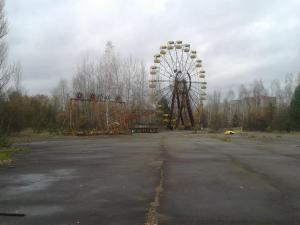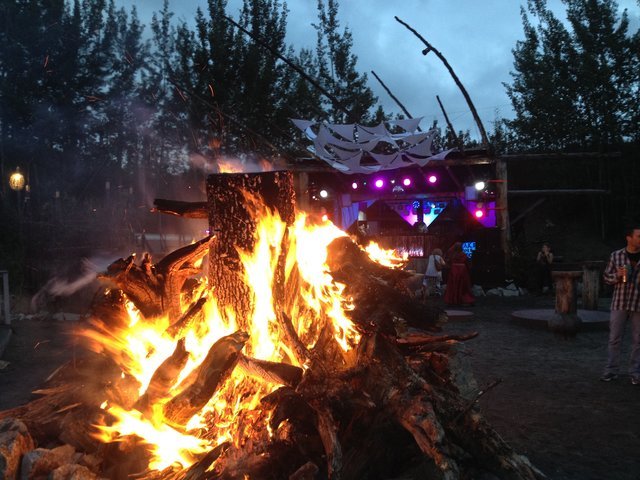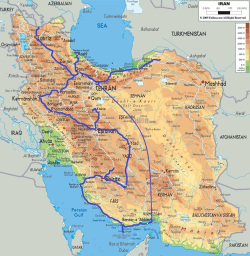
Iran is a contradiction in itself; the first thing you learn is that outside is very different to inside and everything is possible. On the streets women are in hijab and chador (Farsi for tent), alcohol is forbidden and so are many things like walking with a man who isn’t your husband or sitting in the male section of the bus. However, once you go behind closed doors, its like a portal to another world. Alcohol, drugs, sex, dancing, tattoos anything is possible depending on the people you are with. The veil gets lifted once you enter Iran and the more you ask, is it possible to do XYZ in Iran, the more they get frustrated with you; as they begin to wonder what picture gets painted overseas. Well, lets just say its not a good one. We get told its like Saudi Arabia and that the people are oppressed and its dangerous. But instead everything is possible – but only behind closed doors. The only thing that is very restrictive is clothing and relationships and of course the little freedoms people from outside Iran take for granted, from expression of art and religion to being able to purchase whatever you want whenever you want.

Food & Eating
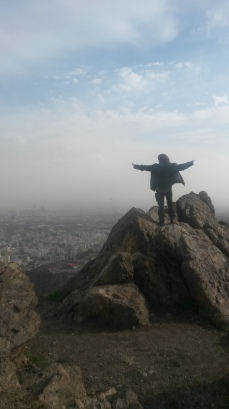 View from Tochal Mountain, Tehran
View from Tochal Mountain, Tehran
There are lots of different foods in Iran depending on where you go. Generally Iran is a mid priced country and food isn’t as cheap as say Georgia or Turkey, its neighbours. Eating in a restaurant you can expect to pay about 300,000 IRR ($9) for a meal and the fast food shops, for example a sandwich are cheap between 25,000 to 120,000 IRR ($0.80 to $4 depending which city you are ) but these can vary widely on the quality of the food. The cheapest and nicest things to eat are soups and fresh samosas and getting bread with cream cheese.
However, the best way to experience Persian food is at home. It basically consists of a ridiculous amount of rice with some meat or vegetables. Often you can have some very different (and I guess to Westerners – strange) foods. For example Farhoode is like a clear, sometimes frozen sweet soup with white almost noodles in it. It is very strange and overtly sweet and extremely popular in Iran to eat. Or Aluche which are tiny green looking apple-like fruit, which when you eat are extremely sour.
The absolute best food is of course Kebab. But not kebab at a restaurant, kebab in the park or someone’s garden or camping in the mountains. Made over a fire and full of flavour. Iranians love to be outside and you will see them put down a carpet anywhere to eat a picnic; from lakes to parks to the side of the road. Expect in Iran also to be fed, constantly. Even if you just ate a large meal an hour earlier, they will offer you more food. Iranians kill with kindness and food!
The meal times are a bit of a strange thing to accustom to. You eat breakfast, and depending on the people, can range between 8-11am and then lunch can be between 2 and 5pm and then dinner can be 9 to midnight. Eating so late can be quite a challenge and the distance between lunch and dinner can be quite long (especially once the heat kicks in). Often after lunch is nap time for Iranians, life is a little slower paced.
Tea is the most popular drink in Iran and expect to be offered it at least a million times a day. Coffee isn’t drunk very much in Iran, so if you like coffee bring some with you. Generally drinks are soft drinks or non-alcoholic beers (which taste nothing like beer). You can also expect sometimes to have Kefir or yoghurt drinks, if you like this sort of thing.
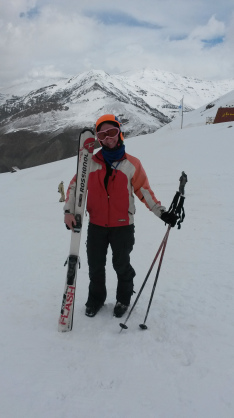 Skiing in Dizin, near Tehran
Skiing in Dizin, near Tehran
Eating also comes with special stipulations, not just related to being fed constantly, but the process of eating in Iran. Generally if you eat with young people there won’t be any special etiquette to follow other than just eating. However, if you are invited into a family’s home as a guest there will be some new customs to get used to.
Firstly, the initial presentation of tea and fruit. You will be given everything first, as you are the guest in the house. The fruit, which usually consists of bananas, apples, peaches, strawberries, and cucumber (yeah, not sure why but cucumber is a versatile food in Iran). You will be given a plate and knife and even if you say no, you will still be given fruit to eat.
Now this will be a snack or after a meal that this happens, if you arrive for just a short period between meals this will occur.
Next comes lunch/dinner. This is sitting on the carpet, where they put a sheet of plastic on the floor and layout plates and fork and spoon (yes, you eat with a fork and spoon, the spoon becomes your knife). Again, everyone will wait for you to take food and start eating…which you will never eat enough to satisfy. If you eat only a little its almost like an insult and they will ask if the food was bad.
You generally get used to eating on a floor and eating with a fork and spoon. The food is good, I’m not sure how vegetarians survive in Iran, as meat is always in everything.
Religion & Government
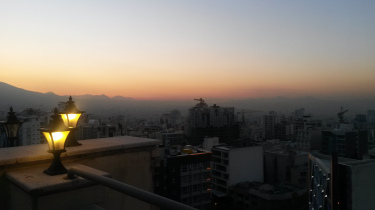 Sunrise over Tehran
Sunrise over Tehran
Iran is an Islamic nation. However, it wasn’t always so. Prior to the Arabs bringing Islam to Iran, Iranians had Zoroastrianism; the ancient Persian religion. This is nothing like Islam. From the people I met in Iran, many aren’t actually Muslim, they are just told they have to be. When asked if they pray, most have never been to a mosque. They identify as Atheist or Agnostic; but legally they must say they are Muslim, particularly when applying for a job interview. And depending which sect of Islam they are can also inhibit them. As one woman said “We must be Muslim, but in our hearts we are not”.
In the mosques there are very few people who are praying that I saw, when asking many people, many don’t or have never prayed. They don’t believe in Islam, they don’t like the hijab. So why not change your country? If no one believes in any of these things, why do them?
I asked many women in Iran about their freedoms and I asked, if the government said hijabs were no longer mandatory, many said they wouldn’t wear it. These are women in bigger cities like Tehran, Isfahan and Shiraz. But asking women in smaller places like Neyriz or Niasar, they still would have to wear them for their family and the perception of the village people. Only one woman I met would wear it, she said “I love the hijab”. It was the first time in the flesh I had ever seen someone pray for Islam, it was an interesting experience to witness.
 Overnight train Tehran to Bandar Abbas
Overnight train Tehran to Bandar Abbas
This is when you get onto the topic of Government because the lines between politics and religion in Iran are blurred. And often, I try to avoid this topic, as I really have little knowledge of the extensively long history of Iran and its important place in the world.
However, many people, after the revolution in 1979, now do not want to fight as they are scared. The government has in place the Revolutionary guard, and my understanding is that this is an army to keep enforcement of the Revolution that was brought into Iran – i.e. Islamic rules.
When you ask, “what’s to stop women, for example, taking off their hijabs?” If 20 million women did this all at once, what could they do? But the people, as we say in English, don’t want to rock the boat. People simply accept it because it is the way things are. As one guy said “the people in power tell us what we must be, but we are Iranians, not Muslims”. Perhaps, after the last revolution and the carnage it has caused for its people; people are scared another one could result in an even worse society (say Saudi Arabia). “Now we don’t need another revolution, we need small change. Small but good change for society. Iran 10 years ago, 5 years ago, even 1 year ago…it’s slowly getting better”, said one artist.
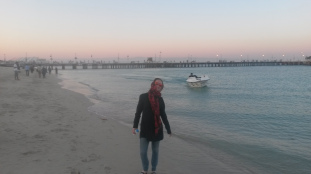 Enjoying the beach, Kish Island
Enjoying the beach, Kish Island
I did have one conservative host while in Iran. He wasn’t a fundamentalist or an extremist or anything like that. He believed in god, prayed to him and lived his life according to the Islamic rules. He was educated, he had travelled to Europe. I asked him would he want to live there, he replied “it is an interesting place to visit, but for your family, to raise your children. Iran is better”. I was baffled, most people I had met would leave Iran with their families if they had the chance. Really? You think Iran has a good government with good rules. “Yes, its good. They follow Islam and make sure everything is good for the people”. So you think hijab is good. You think people being arrested for painting the wrong picture or saying the wrong thing is ok? “This is Islam. Iran is a very good country”. I questioned him for hours, curious to this complete opposite understanding and belief I had gotten from most Iranians on my travels.
One night I walked down a road in Niasar and met an older man who was studying in America when the revolution took place. I asked if he experienced any issues in America for being Iranian at the time, he said no problems at all. What was it like going back to your country after the revolution? He said “I came back to what was once my country, to a country I could no longer recognise. Even 30 years later, I still can’t recognise my own country”.
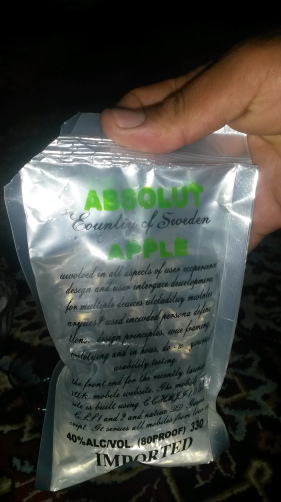 Vodka in a pouch, Shiraz
Vodka in a pouch, Shiraz
Staying in Tehran with a tattoo artist, who 3 years previously had been arrested for his job, was an interesting insight into the frustration, particularly the artistic communities have within Iran. For example, during the 2009 elections, the issues he and his friends faced. Having the police take him from his home for three days and permanently confiscating all his artwork and images. Having to flee from the police, when he and other young Tehranians decided to have a massive water fight with plastic guns in the middle of Tehran….yes, a water fight. Apparently, anything fun isn’t allowed in Iran.
But to meet people with so much talent for art, music, theatre, dance…all these people unable to fully express their passions and abilities with the world. It’s sad. To know that my new friend’s boss was arrested for directing a rap video. You forget where you are when you are inside a home where people talk about everything, drink, dance and so forth. You forget that its still a police state and slowly find that the small things us Westerners can do freely, aren’t possible in Iran.
Will there be a change? Maybe…many say no, but it would be interesting to see Iran as the people want and if they ever do change their Islamic enforcements. It’s an Iran I would love to see.
Beauty & Dress
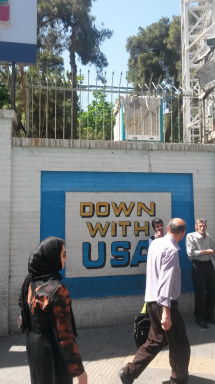 Ex US Embassy, Tehran
Ex US Embassy, Tehran
The first thing that is the most obvious difference in Iranian dress is the hijab and chador (Persian for tent and means the black long sheet women wear). At first when you arrive in a larger city, especially Tehran, you are shocked at how loosely this is enforced with the young women. The hijab is almost non-existent, their sleeves are rolled up, coloured hair, tight fitted dresses and jeans, with lots of make-up. In Tehran I often felt I was actually covering up more than the Iranians.
However, when you head to the smaller villages you will see very young girls with full chador, and even baby girls (months old) have a scarf put on their head. The differences in culture and expectation are quite severe between the cities and villages. In the smaller villages it is enforced and expected to cover a lot, especially with full chador as everybody knows everybody.
I asked when was the actual enforcement age for girls to start wearing the hijab and I was told it is 15 years old. However, when the girls are in school uniform, even at 6 years old, they wear a hijab.
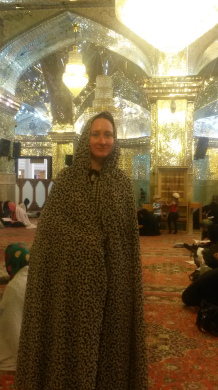 Wearing Chador in Shah Cheragh, Shiraz
Wearing Chador in Shah Cheragh, Shiraz
It’s quite interesting to ask the women and even the men about hijab. Many do not like it nor would they want to wear it if it was no longer mandatory. However, in the smaller villages many girls would still have to as their family would want them to. So if Iran did remove the hijab enforcement you would see the evidence immediately in cities like Tehran and Shiraz, but it would possibly take some generations for it to happen in smaller villages.
On the streets is one thing and inside is something completely different; but again it depends on how religious or how confined a family may be. Once inside the hijab comes off and girls have t-shirts (midrifs tops I’ve seen), even shorts inside the home. However, sometimes, women still wear it if there are men, even if family members, inside a home. I was couchsurfing in Kish Island and the guy had invited several people, including German and American men. His wife would wear hijab in the home if they were in the house. However, if it was just me at the house, she would take it off. They also (while the two foreign guys were staying) had 2 Iranian women stay who were sisters. One removed her hijab and
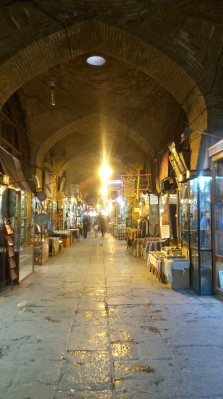 One of many Bazaars
One of many Bazaars
dress and wore a t shirt, the other stayed and slept in her dress and hijab. So even within a family you can have different levels of comfort for dress. For the men, t-shirts are fine, shorts are generally not accepted outside the house, even when going to the beach or in hot weather. You will find men will spend much time on their appearances, with slick hair dos, where they will spend time blowdrying their hair and often, the more body consiscous types will have shaved chests, arms and so forth. Metrosexuals are everywhere!
The definition of beauty in Iran is also quite interesting, the more “Western” and wealthy of Iran desire altered facial features. Its not uncommon in cities to see many – both women and men – with plasters on their noses; with nose jobs the most popular beauty treatment. Even many wear a plaster, without having had a nose job, just to give the illusion they had. In Kermanshah I was at a party and the women were young, mid-twenties and had so much work done to their beautiful faces they looked like the cat lady and Michael Jackson. I asked them why!? Was it your boyfriends, your husbands, your family, society? What would make you do this to your face? “It looks good”. These were the Iranian wealthy and their husbands constantly asked if I thought their wives were beautiful….ummm.
A few times I got made fun of because of my dress. “Mister, mister”. Actually being asked if I was a man or woman, as they were legitimately unsure as to my sex (I must be the most unhairy man in history). The women wear very feminine clothing and lots of make up. One woman asked me, “why don’t you wear make up”. I said “the time it takes to fuff about with shit like that is a waste of time”. She didn’t understand me at all and said “but it would make you look pretty”….hmmm, natural beauty doesn’t seem to be a popular concept with women or men in Iran. But maybe its because a woman’s face is the only thing to display in public, so its become the place to spend the most time and money.
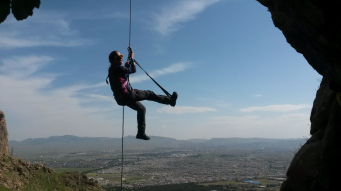 Rock Climbing, Kermanshah
Rock Climbing, Kermanshah
If you are lucky enough to see wedding photos of young Iranians, you will see, even the most religious women who normally wear chador and no make up, with princess dresses and so much make up they look like they will smile and their face will crack. It’s really a shame, Iranian women are natural beauties. But just remember being a tourist, you generally get away with a lot more than Iranians would and the “moral” police will alert you if you are dressed inappropriately.
Culture
Iranian culture is quite different to the Western culture but shares a lot of similarities with its neighbours, like Turkey and Georgia. The family unit in Iran is extremely strong. Majority of young people live at home with their family and most families live all near each other or in the same house. When I was in Neyriz there was an alley of houses and it was all occupied by the same family.
 Hitchhiking, Bandar Charak
Hitchhiking, Bandar Charak
In the smaller villages (and possibly in the larger cities), it is ok in Iran to marry your first cousin. I found this quite surprising but apparently it can be quite common. It can also be common in smaller villages for the girls to be married very young. When I was in the hospital in Bandar Abbas, there was a young pregnant girl who was also getting an IV drip. We asked her and she was 19 pregnant with her second baby. She had been married at 14 and her husband was 4 years older than her. We asked if she had chosen to get married that young and she said “no, it was my family”. So here sits a girl who never really got much chance to be a child who was about to issue another.
In Tehran, Shiraz and Isfahan you are more likely to find young people who live alone or with friends. Here you find a very different culture than those living in smaller cities and with their families. The people with the most liberal parents have the most opportunity to be themselves, whether they live with their family or away. You can hear it and see it when they interact with their family members.
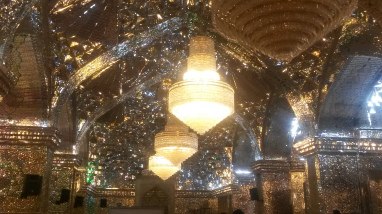 Shar Cheragh, Mosque, Shiraz
Shar Cheragh, Mosque, Shiraz
In Iran you can often find people are very curious about foreigners especially why anyone would want to travel their country. When you walk the street, you will be stopped and asked where you are from and that they welcome you to their country. Having travelled many places, you tend to just say no, no, and walk away, as it can be a harassment. But in Iran, they genuinely want to just talk with you and welcome you. Many want to use the two or three phrases they know in English. Many will want to take a selfie with you or show you around or welcome you to a drink or food. Often in places like Shiraz and Isfahan you can’t walk one hundred metres without being stopped a hundred times. But in smaller, less touristic cities, people just stare. Literally stop and stare at you. Terrified to talk to you. You may get a quick “hello” and they run away from you. Yes, run. It’s all with good intentions, but you do miss being able to walk down a street like any other normal person.
Transport
Iran has a lot of bus connections and is the cheapest method to get around. You get more for your money the further you go and the non-VIP buses are the cheapest and minibuses are the absolute cheapest; but not always available. For example a bus from Shiraz to Yazd was going for 350,000 IRR ($10) but from Neyriz to Yazd is only 150,000 IRR ($4), a bus from Busheher to Shiraz was 260,000 IRR ($8), bus from Yazd to Isfahan 130,000 ($3). Minibus from Kermanshah to Hamadan 60,000 IRR ( $1.80), bus Hamadan to Qazvin 200,000 IRR ($6), bus from Rasht to Tehran 150,000 ($4), Tehran to Gorgan 185,000 IRR ($5), the longest bus I took was Gorgan to Tabriz for 17 hours and cost 614,000 IRR ($18), you could get for a little cheaper say 100,000 IRR if you took a non-VIP bus.
 Prayer Time, Neyriz
Prayer Time, Neyriz
The trains are quite comfortable and cheap, but only cover certain parts of Iran and so may not be the best option depending on your route. The overnight train from Tehran to Bandar Abbas was 18 hours and cost 600,000 IRR ($18). It is also possible to get a cheap flight last minute. For example you can get a flight for maybe 300,000 IRR ($9) from Tehran to Kish or Shiraz to Tehran for 1,000,000 IRR.
There are also shared taxis which can sometimes be cheaper than the bus, it depends on the distance you head. For example a taxi from Bandar Abbas to Bandar Charak is 350,000 IRR ($10) but from Port Pol to Bandar Charak is the same price per seat and half the distance. The issue with shared taxis is that the journey costs a certain amount and if you are only one, you pay for all the seats. So for example the total cost was 1.4 million IRR ($40). Once you are in a city there sometimes can be buses, depending on its size, however, most Iranians expect you to take a taxi. Relative to other countries, taxis are cheap, but obviously the public buses are cheaper. In most cities you can expect to pay between 30,000 to 100,000 IRR from the bus station to the centre versus the public bus which is maybe 3,000 to 5,000 IRR. The most difficult part, especially if arriving into the train or bus stations, is that the taxi drivers can be quite aggressive and annoying. You have to be pretty clear that you don’t want a taxi, if you walk fast and just shake your head and head inside to terminal information for where the bus station is located. Once I get off a bus, I get my bag and just walk off. Shared taxis are good, but difficult to navigate which roundabout to which roundabout or which street to street they go. Going with an Iranian is best way to use them. The only city with a metro is Tehran.
Hitchhiking is possible in Iran, but it is not really understood in Iran. It’s a foreign concept to them. There are several ways you can try to get picked up. For example walking down the road that you want to catch the car or you can hold a sign. The issue with a sign is that often taxis or cars that will charge you will stop. So you must be clear that you don’t want a taxi or that there is no tariff. It can be difficult to convey this message to people as they don”t understand. However, when you say “no toman”, they say either no or yes. So then you can be clear; if you don’t make it clear you can end up in an awkward situation where you get out saying thank you, and they hold their hand out for money. Typically people charge about 100,000 IRR ($3) per 100km. Generally I had ok experiences, but it can be quite difficult. At one point I got in a car, immediately the guy grabbed my leg and said “hotel?”. I slapped his hand away and told him to stop the car. I genuinely think being two girls or a guy you will have fewer problems.
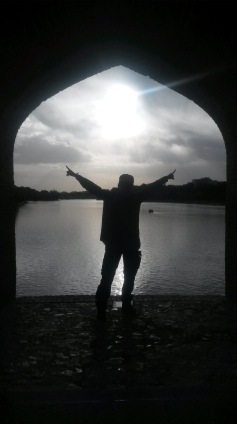 The beautiful bridges of Isfahan
The beautiful bridges of Isfahan
Often you can be walking for some time, and it can be very hot. You can also try holding out your thumb (which is actually ‘fuck you’ in Iran; but nowadays they know that to Westerners it is not – thanks to the blocked/banned facebook ‘like’ button), but again, hitchhiking is a foreign concept. However, if you do hitchhike or take the bus expect the people to invite you to their homes. This comes under hospitality.
Hospitality
Iranians are famous with their hospitality. They have a concept called Tarouf, which means that people in Iran will offer you something, and you should decline at least 3 times to make sure they are serious. If after three times they don’t offer you whatever it is then you know they didn’t really intend to. I haven’t really experienced this in Iran, when I say no they don’t seem to understand – no matter how many times I say it. It’s actually impossible to decline anything in Iran.
As an example, when I arrived in Shiraz bus station I went and found the bus after being stalked by all the taxi drivers and the bus arrived I got on at the front (the front section is for men only), but I asked if ok as I didn’t know where I was going and it is much more comfortable being near the bus driver. The driver spoke quite good English and I asked how much the bus was, he said 5,000 IRR. I get my money and he says “no, you are our guest”. He then asked a man to go and buy me a drink and brought it to me on the bus.
When I was hitchhiking from Estahban to Neyriz I was picked up by a man, and next thing I am meeting about 30 family members, being shown off in the village as some sort of exotic creature. You feel like a celebrity, as for many in the smaller villages you are the first foreigner people have ever seen. I went with my host (who was an English teacher) to their English institute and I felt like a rock star. I had about 100 photos taken with me and the teachers and students and signed s many pieces of paper. They gave me food, a place to stay and then the next day they paid for my bus ticket as they didn’t want me to hitchhike.
 Desert Sand Dune Riding, Yazd
Desert Sand Dune Riding, Yazd
When I stood at a public bus station to head from my couchsurfing hosts house to the centre a guy stopped and offered to take me into town. He had the cutest pomeranian dog sitting on his lap. His family was amazing, they took me to the desert with their cousin’s 4WD to ride the sand dunes and hosted me for one night.
I had decided from Isfahan to go take a day trip to Kashan to go see the Rosewater festival (the pink flowers that make “Gom”, rosewater). So I took a bus and when I arrived asked at the bus station, where do I see these flowers. They said Niasar. They organised for me to get on a bus heading for Tehran to take me to the taxi stop. I said no taxi. I wanted to try and hitchhike, unfortunately, a policeman and a military guy and others had surrounded me. See when you try to hitchhike in Iran as a single female, they pretty much try to stop you. They fear for your life. So I get in a shared taxi and the girl I sit next to says, to see the flowers you must wake up early and only in morning. Shit. She invites me to stay at her home, take me around and in the morning take me to the flowers.
If someone in Iran says “you are my guest”, expect them to take complete care of you. It is one of the safest countries in the world for tourists.
Tourist Sites
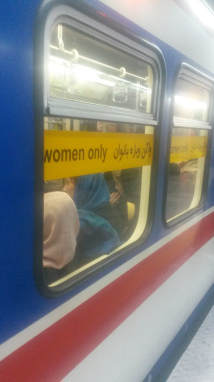 Segregation on all public transport
Segregation on all public transport
Generally you can experience quite a lot for free in Iran. One of the nicest things is their parks and these are all free in Iran and quite a good place to camp. However, once you get to any tourist sites like a major mosque or ancient ruins the price for entry is a pretty much standard 200,000 IRR ($6). For Iranians it is usually only 30,000 IRR (less than a dollar).
Here is a list of the most worthwhile to pay to see; Persepolis (200,000 IRR near Shiraz), Nasir-al-Molk Mosque (150,000 IRR shiraz), Star Valley (20,000 IRR Qeshm Island), Women’s/men’s beach (100,000 Kish Island), Tochal mountain (70,000 IRR to first lift station, XXX IRR to top – you can walk up for free. Tehran), Yazd Desert (1,200,000 IRR for a car for a few hours, can be split with up to 4 people, Yazd)
The top sites to see for free are; Shahcheragh Shrine/mosque (Shiraz), Greek shipwrecked ship (Kish Island), Mangrove forest (Qeshm Island – you can take a shared boat around also for 100,000 IRR ($3)), Mount Baba (Shiraz), Paraw Mountain (Kermanshah), Bisotun Wall (Kermanshah), Mount Alvand (Hamadan – can also take telecabin), Mount Tochal (Tehran – can also take telecabin), Former US Embassy (Tehran), Golestan National Park (near Gorgan)
Accommodation
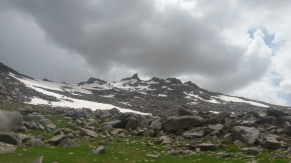 Mount Alvan, Hamadan
Mount Alvan, Hamadan
Hostels are pretty standard in Iran, they go for about $10 to $15 for a dorm bed, which if you are on a budget can be quite high. Couchsurfing is not really known throughout Iran but in a lot of cities you can find people on it; for example there are 30,000 hosts in Tehran. In the larger cities or touristy ones like Tehran and Yazd it can be difficult to find hosts or reliable ones. The best way to use couchsurfing is have several people say yes and get several contacts, so once you arrive you have options if people pull out or also for people to help you when you are in the city. Couchsurfing is also illegal in Iran, as when you arrive to a city you should be registered with the police. I was told you can only stay in a person’s home for maximum 2 days. A host I had in Yazd advised me that there was an undercover agent who had a few couchsurfing hosts caught! So sometimes when you are hosted by people who live in an apartment block or in a conservative neighbourhood, you must be quiet and hidden, just in case. Sometimes, sitting in the car hiding or being dropped a street away happens, so neighbours don’t see you with hosts (this is usually when you stay with a single man).
When you are courchsurfing or have been invited to stay in people’s homes, accommodation is generally a carpet. Its where you eat, drink, talk, sleep. Getting used to sleeping on the floor can be an adjustment, however, if you only stay in hostels then you won’t experience this. And then you won’t experience the real Iran. At one point I stayed with 5 guys in the one room in Shiraz. Often in a typical house you have just endless carpets on the floor, sometimes people may have actual couches, but often it will just be a room with carpets. That will be the living room, dining room and bedroom all rolled into one. However, you can sometimes get hosted by quite wealthy families. The more rich families have Western style houses, with beds, European toilets and showers. You can also use the facebook group “See you in Iran” for posting to help find place to stay and also people to meet up with.
Another option, and quite popular in Iran, is camping. You will find pop up tents everywhere in the parks or where there is any grass at all like a roundabout or middle of the road. I think you are not supposed to camp on the grass, hence they all have pop up tents, however, my tent needs to be pegged to the ground, so only once, did I have to explain to a grounds person that we needed to stay on the grass in a park. Being a tourist, however, seems to have a certain flexibility in Iran. People will allow you to do much more than what would be normally acceptable for Iranians, because you are a tourist.
Sex and Relationships
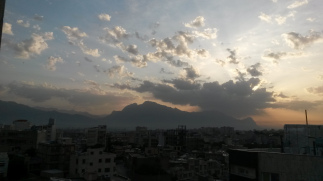 Sunset over Kermanshah
Sunset over Kermanshah
Possibly the most curious part for me to want to find out in Iran and also the most difficult to gather for information, as it is not a topic many talk about. In public relationships are very strict. Technically if a man and woman walk together they can be asked their relationship and if they aren’t married they can get into trouble. However, married couples on the streets can sometimes be seen holding hands. But the extent is only to this (unless you are far from public and police), you won’t see anybody kissing in public for example.
So you wonder how are people supposed to date in Iran? It all happens behind closed doors. I mean the buses are segregated, almost everything is split so men and women are only together if they are related or married in public. But people meet at parties and then from there must ask friends to use their houses or go to cafes to be able to talk with each other (unless they already live alone or away from their families). Away from families and prying eyes. It can be quite difficult to organise sex in this manor and seems as though sex is an infrequent act., unless you are lucky enough to have a friend with their own apartment – then it becomes a sex and drinking den. Often people refer to sex as “intercourse” which is a more clinical term and you begin to wonder if it is actually a pleasurable act or just purely for procreation. Staying with many different types of families (not including the young people who have their own flat), everyone shares the same room.
When first arrived in Tehran, staying with some couchsurfers they had on their table condoms. I was curious, wow like, so you can get condoms in Iran, is it difficult? Having absolutely no idea how anything works in Iran. They said it is easily possible to get condoms and you don’t get any issues. It is also possible to get birth control over the counter and morning after pill. So clearly, if these things are so easy to obtain without question, why is sex such a taboo subject? Perhaps its also the exposure you have to the people around you. It seems as though a lot of men, if you stay with them, are actually more terrified of getting into trouble if they try anything. At one point me and one Iranian guy were getting on very well. I was interested but thought he wasn’t interested in me. Then when I left and we talked on Telegram; he said he thought I wasn’t interested. He said “you was guest in my home, I say that not good in Iranian moral, for this we do not ask”. Eventually, once I adapted more into how Iran worked and the fact you need to be a bit more forward to get anywhere. I hooked up with a couple of Iranian men.
The main difference really is that the girl has to make the first move and, unlike Western men who tend to try and convince girls not to use condoms, Iranian men strongly and without demand, use them (they are too scared about having children; as their family notions are much stronger than Western ideas and expectations). Educated men in Iran are terrified to get married early, once they get married then that’s it. But they will have to, at some point. They are particularly worried about having kids young and the cost of having them. Much more aware than Westerners. But it was quite interesting that really they are more or less the same as any other men in the world. They didn’t seem fazed that they had girlfriends they were cheating on. I think also with such a restrictive society for sex and pleasure they are eager to experiment, with at one point an almost threesome that took place, if not interrupted by a fourth party.
Coming from outside of Iran and having freedom to love whoever I want or just simply take pleasure in another person’s body; and to express it in public or not, in anyway I choose; its difficult coming to a very sexually oppressed country like Iran. It’s not natural for people to be restrained in such ways. I would be curious to know if its even possible for homosexuals in Iran, considering how confined heterosexual sex is. I wonder how much sex and relationships would change if the rules loosened.
Alcohol and Drugs
These two vices may be illegal in Iran (like almost everything fun), but they are quite easy to obtain. The low to middle class Iranians generally will make their own alcohol or know someone who makes alcohol and the high class Iranians will purchase packaged alcohol (like Absolut vodka) which is smuggled in from Armenia. For example, if you buy a litre of Arak (Iranian type vodka) it will cost about 600,000 IRR $18.
Drugs are also quite common in Iran, particularly weed. If you go to any big park at night, you will most likely find young men smoking weed or by the beach in the south. In the south of Iran, Opium was also available and in Tehran cocaine and opium was popular.
Basically anything is possible in Iran.
Money
The most annoying thing to get accustomed to in Iran is the money (well other than the hijab and the fact everything is illegal). The actual money i.e. The notes and coins, are Rials; however, when prices are listed or people talk about money they refer to Toman. This means if someone says the cost is 2 or 2,000 its toman, which means its 20,000 Rial. Confused? Yep, it is. Not only is it difficult enough to convert Rials, but you have to put Toman to Rials to convert to know how much something is.
At the moment approximately 34,000 Rials is about 1 USD. You can exchange at exchange offices which are the best. I was told someone’s American money in Kish was rejected because it was older than 2007!
When you exchange money they will usually give you large notes like 500,000 and 1,000,000 Rials. You need to break these as soon as you can. Because in small shops they won’t change them. So when you get a bus ticket or go to a tourist site, use these to get smaller notes. The most common notes you will use are 5,000, 10,000, 20,000, 50,000 and 100,000. They do have coins! And they are a pain. There are also smaller notes, but not as common.
Also in terms of pricing, sometimes (not always) you may be cheated on the price of things. Its best, especially transportation, find out the approximate cost. That way you can walk away and they will know to lower the price to the Iranian price. Unfortunately, people (not just Iranians), see a white Western person and think dollar signs. For me, living in much much cheaper Georgia meant Iran was much more expensive and as such when Iranians say things are cheap, they mean in comparison to Europe/America/Australia, which is debatable in regards to cheap. I believe Iran is a mid priced country, with countries like Georgia, Thailand, Macedonia being much much cheaper (as an example). I managed to survive on less than $10 a day; however, this often led to missing out on opportunities for fear of running out of cash in Iran. If you intend to stay in hostels and eat out a couple times a week, then expect to pay upwards of $30-40 a day in Iran for travelling. Your bank card won’t work in Iran (although it is possible to get transferred money and take from places in Tehran for a heft fee), so make sure to bring enough cash with you!
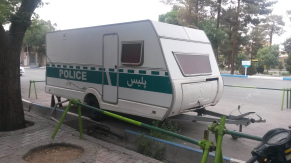 The police are everywhere
The police are everywhere
Tips and Advice
- Things you should bring with you to Iran: good coffee, sunscreen
- Install whatsapp and telegram on your phone
- Get an Iranian sim card and get data on your phone
- Bring enough money with you for the type of trip you want – absolute budgeting $10 a day
- Staring & Strangeness. Be prepared, everywhere you go in Iran you will be stared at, talked to, assisted with whether you want to or not. The biggest thing to prepare is the staring, particularly if you travel outside the biggest tourist cities (Shiraz, Isfahan, Yazd and Tehran).The cities most used to tourists like these, most Iranians will greet you and talk with you, and also stare, but have seen many tourists. They enjoy it. But outside these places, you may be the Iranians first foreigner or they may have seen one of 2 ever in their lives. When you walk down the street, people will stop and stare. Often they are much shyer than in the bigger tourists cities, so when you walk down the street, sometimes you can feel as though people stare with dislike. But it has nothing to do with this. You are just extremely rare and strange to them. They are curious and shocked.
- Learning the numbers (which takes about 5 minutes) will also help. As most things like menus and bus destinations will be written completely in Farsi and knowing the numbers at least you know the cost of something. Generally everything is written in toman, so add an extra zero to the price. When people discuss prices you will get a better understanding of how the money is talked about. For example if you are buying a sandwich and ask how much, they will say 5. This will mean 50,000 Rial or 5,000 toman. But if you are at the bus station getting a bus and they say 2, it will mean 200,000 Rial or 20,000 toman. Because of the number of zeros in Iranian currency, they shorten everything. So the value of what you are talking about will determine how many zeros. Always best BEFORE you take anything is to agree price. This is on a calculator and ask toman or rial.
Iran is an extremely complex country, with some incredible landscapes that vary from desert to jungle, from snow-capped mountains to reefed clear waters. The people also vary dramatically, as does the food, culture, religious beliefs and so forth. You cannot put this large country under one category for anything.
I feel lucky to have experienced the country now rather than later, as each year this country and its people change. And the more tourists who come will influence incredibly the shape of this country for the future.
The biggest thing for me, coming out of this experience was really understanding and appreciating my freedom. Some days I would walk with my Iranian male hosts down the street in 30+ degree weather. Them wearing t shirt, casually walking, me having to be covered completely with hijab. Frustrated, annoyed and angry as why I must dress like this and he doesn’t have to. What did I ever do, other than being born with a reproductive system, that warranted this kind of restrictive punishment?
Most days it was bearable though. But it often made me sad, especially meeting many strong, talented, smart Iranian women. They have never known what it was like to go to school without wearing a hijab. That outside this country, in the Western world, women can choose any life they want; get married to whom they want, work any job they want, have kids, not have kids.
But even the sadness I have for the women who will never experience freedoms like this, I also feel sorry for the men. Its the simple things that we take for granted in the West. Things like being able to love who you want, be able to walk down the street holding hands. All the freedoms I grew up and once left Iran, have again….while I leave these incredible people behind who may never get to experience this in their lifetimes.
